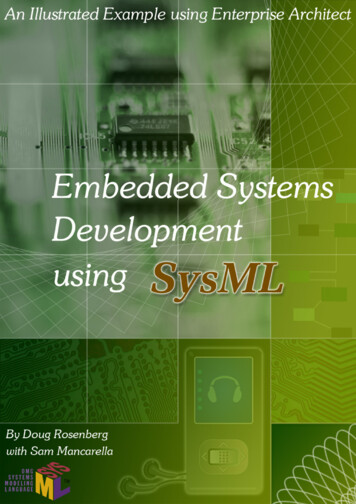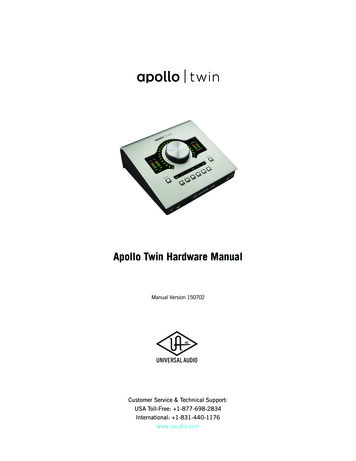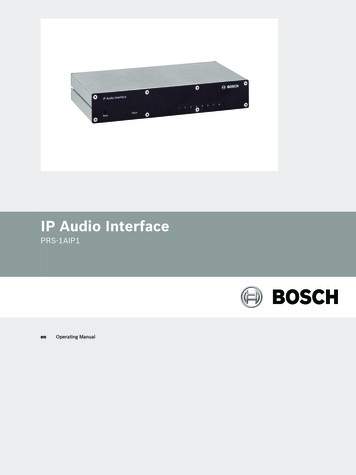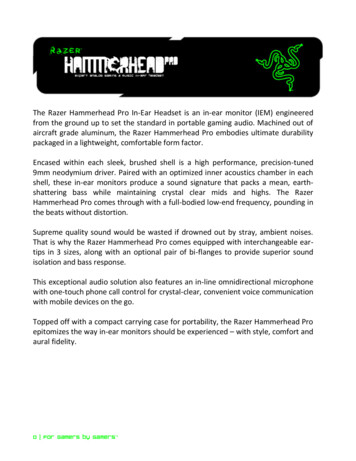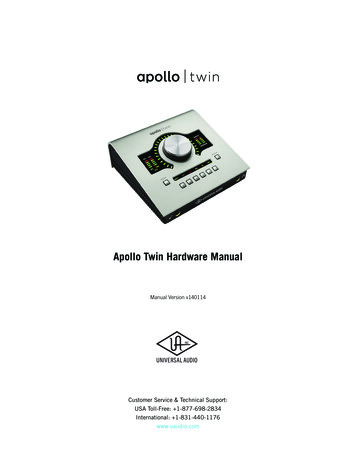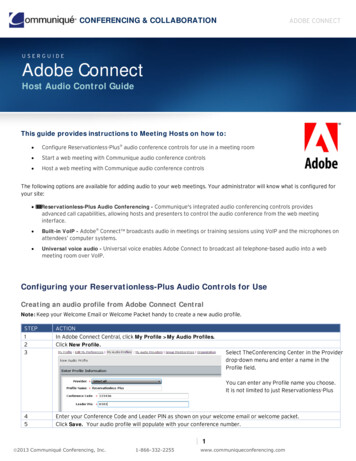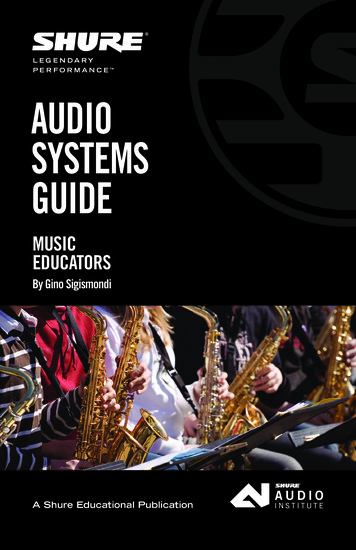
Transcription
AUDIOSYSTEMSGUIDEMUSICEDUCATORSBy Gino SigismondiA Shure Educational Publication
Audio Systems Guide forTa ble of ContentsMUSIC EDUCATORSIntroduction . . . . . . . . . . . . . . . . . . . . . . . . . . . . . . . . . . . . . . . . . . . . . . . . . . . . . . . 4Recording . . . . . . . . . . . . . . . . . . . . . . . . . . . . . . . . . . . . . . . . . . . . . . . . . . . . . . . . . 5The Parts of a Recording System . . . . . . . . . . . . . . . . . . . . . . . . . . . . . . . . . . . 5Microphones . . . . . . . . . . . . . . . . . . . . . . . . . . . . . . . . . . . . . . . . . . . . . . . . . . . 5Recording Devices . . . . . . . . . . . . . . . . . . . . . . . . . . . . . . . . . . . . . . . . . . . . . 10Mixers . . . . . . . . . . . . . . . . . . . . . . . . . . . . . . . . . . . . . . . . . . . . . . . . . . . . . . 11Hooking it up . . . . . . . . . . . . . . . . . . . . . . . . . . . . . . . . . . . . . . . . . . . . . . . . . 12Sound Reinforcement for Music . . . . . . . . . . . . . . . . . . . . . . . . . . . . . . . . . . . . . . 12A Basic Sound System . . . . . . . . . . . . . . . . . . . . . . . . . . . . . . . . . . . . . . . . . . 12Microphones . . . . . . . . . . . . . . . . . . . . . . . . . . . . . . . . . . . . . . . . . . . . . . . . . . 13Mixers, Amplifiers and Loudspeakers . . . . . . . . . . . . . . . . . . . . . . . . . . . . . . . 17Signal Processors . . . . . . . . . . . . . . . . . . . . . . . . . . . . . . . . . . . . . . . . . . . . . . 19Hooking it up . . . . . . . . . . . . . . . . . . . . . . . . . . . . . . . . . . . . . . . . . . . . . . . . . 22Sound Reinforcement for Theater . . . . . . . . . . . . . . . . . . . . . . . . . . . . . . . . . . . . . 23The Realities of Theater Sound . . . . . . . . . . . . . . . . . . . . . . . . . . . . . . . . . . . . 23Lavalier Microphone Techniques for Theater . . . . . . . . . . . . . . . . . . . . . . . . . 25Summary . . . . . . . . . . . . . . . . . . . . . . . . . . . . . . . . . . . . . . . . . . . . . . . . . . . . . . . . 27Recommended Shure Microphone Models . . . . . . . . . . . . . . . . . . . . . . . . . . . . . . 28Appendix . . . . . . . . . . . . . . . . . . . . . . . . . . . . . . . . . . . . . . . . . . . . . . . . . . . . . . . . 29About the Author . . . . . . . . . . . . . . . . . . . . . . . . . . . . . . . . . . . . . . . . . . . . . . . . . . 29Glossary . . . . . . . . . . . . . . . . . . . . . . . . . . . . . . . . . . . . . . . . . . . . . . . . . . . . . . . . . 30Music Educators3
Audio Systems Guide forMUSIC EDUCATORSIntroductionAn often overlooked yet vital part of modern musical performances is the soundreinforcement (PA) system. In a perfect world, a trained professional would always beavailable to purchase, setup, and operate the sound system. In reality, the funds arenot always available for such a luxury. The responsibility then falls to the next mostlikely person available to run the sound system, the music director. After all, you justneed a few microphones and a couple of loudspeakers, and it’s time to go on tour!And we want it recorded as well!Unfortunately, sound system setup is not quite that simple. It doesn’t, however, needto be overly complicated. While the extreme quantity of choices available at your localmusic shop may seem daunting (Cardioid? Dynamic? Low Impedance! Help!), with afew basic guidelines, you can learn what you need, how to connect it, and even howto make it sound good.This guide will help you choose equipment for a variety of typical applications.Recording will be discussed first, due to the smaller number of required components,and reduced complexity. Feedback and room acoustics play a small (or evennon-existent) role in basic recording. Additionally, many of the microphone, andpossibly mixer, choices made for recording are equally applicable in live soundreinforcement. Remember, there are few rules in audio – if it sounds good to you, itis good. For every application, there will be a good, better, and best option. A littleknowledge and some common sense will allow you to choose a good system with areasonable budget and a minimum of frustration.For those interested in the more technical aspects of audio equipment, Shure publishesseveral booklets on a variety of audio topics, including specific microphone techniquesand wireless microphone operation.Introduction4
Audio Systems Guide forMUSIC EDUCATORSRECORDINGWhat do I need?The parts of a recording systemTo make a decent recording there are two or three components to consider:1. The first, and most important, is the microphone. Choosing the right microphoneensures accurate pickup of the desired sounds.2. Next, consider the recording device. Recording equipment comes in many shapesand sizes, from simple cassette tape recorders to advanced digital multitrack machines.3. Lastly, depending on the capabilities of the recording device, you may need a mixer.A mixer’s purpose is two-fold; they are used to combine (or "mix") multiple microphonestogether, and to properly interface microphones to the recording device. Most consumerquality cassette tape recorders, for example, do not allow a microphone to be directlyconnected to the record inputs. A microphone has an extremely low output level that wouldresult in little or no signal actually making it to tape. A mixer provides gain, which raises thesignal level from the microphone to a level that is acceptable to recorders that don’t havemicrophone inputs.MicrophonesThe most important questions to ask when choosing microphones are:a) what are you recording? andb) what are you using to record?First, a little about microphones. Microphones are basically simple devices designed todo one thing: convert sound waves in the air to their electrical equivalent. One of the firstquestions you may encounter is, "Do you want a dynamic or condenser microphone?" Theseare the two most popular types of microphones in the world. Dynamic microphones are typically inexpensive and rugged, with fairly lowsensitivity. In layman’s terms, this means they are good for handheld or "close-miked"applications. Dynamics are commonly used for solo vocalists and on drum kits. Condenser microphones, on the other hand, are typically (but not always) much moresensitive than dynamics. Make a good quality condenser microphone your first choice formiking ensembles, or other applications where the microphone will be placed at a distance( 2 ft.) from the sound source. Condensers are typically used for recording orchestras,choirs, and in other applications where you wish to capture the sound of the ensemble,versus individual sounds.5
Audio Systems Guide forMUSIC EDUCATORSCardioid (Unidirectional) MicrophoneSupercardioid MicrophoneAnother characteristic of microphones that will determine the best choice for yourapplication is their directionality, or “polar pattern.”An omnidirectional microphone has equal sensitivity at any angle. Sounds arereproduced equally whether arriving at 0 degrees (on axis) or at 180 degrees (the rear of themic). The important thing to remember is that omnidirectional microphones will pick upambient or room sound as well as the sound you intend to amplify or record.A unidirectional microphone is most sensitive to sound arriving on axis and less sensitiveto sound as it moves off axis. Using unidirectional microphones can allow higher gain levels fromthe sound system before feedback becomes a problem. There are two primary types ofunidirectional microphones. Cardioid microphones exhibit an upside down heart-shapedpattern with a 130-degree pickup angle in front. Sound is greatly attenuated at 180 degrees.Supercardioid microphones exhibit a narrower pickup angle of around 115 degrees in front andtherefore are even less sensitive to ambient sounds.6
Audio Systems Guide forMUSIC EDUCATORSFigure 1: Choir microphone positions - stereo top viewLarge ensembles (band, orchestra, choir)Use a stereo microphone setup to most accurately capture the sound of a largeensemble. Stereo recording is not as complicated as it sounds. For simplicity sake, we’ll usethe most basic type of stereo microphone techniques, the X-Y pattern. Use twomicrophones of the same model with the two mic capsules placed as close as possible, andfacing each other at an angle ranging from 90–135 degrees, depending on the size of thesound source. (see figure 1). For a wider coverage area, the larger angles should be used.The X-Y pattern results in good stereo separation and excellent mono compatibility.A second, somewhat simpler way to record in stereo uses what is known as a"single-point" stereo microphone. These types typically have a single microphonehousing that contains two microphone elements, electrically combined to produce a stereooutput. The advantage to this type of microphone issimplicity; put the microphone on a stand and point it at0.6 - 1mwhat you want to record.(2 - 3 ft)When recording a large ensemble, you may chooseto use more than two microphones to adequately covereach section. A technique known as "area" coverage uses0.6 - 1mmultiple microphones to cover small sections of the(2 - 3 ft)ensemble. Using a choir as an example, use onemicrophone for each 6-9 foot wide section, and aim themicrophone capsule towards the last row. Microphonesshould be placed 2-3 feet in front of the first row of thechoir (see figure 2). The same technique can be appliedto concert band or orchestra, by using one microphoneFigure 2: Area miking - side viewper section.7
Audio Systems Guide forMUSIC EDUCATORSRecommended Equipment 2 cardioid-pattern condenser microphones Microphone stand(s) Stereo microphone adapter or “T-Bar” Microphone cables with XLR connectors Stereo microphone mixer with at least2 microphone inputs Recording device (see next section) Cables to connect mixer to recording deviceSmall ensembles (jazz combos, string quartet, vocal jazz groups)The stereo techniques described above can also be successfullyapplied to smaller ensembles, but to achieve a more "pop" sound, usemultiple close microphones, generally one per instrument. On thefollowing page are some simple techniques for getting good soundsfor a variety of instruments or vocals.Example of aCondenserMicrophoneRecommended Equipment* Vocal microphone Guitar amplifier microphone Drum microphones Piano microphone Woodwind microphones Brass microphones Microphone stands Microphone cables with XLR connectors Microphone mixer with enough inputs to handlethe desired number of microphones Recording device (see next section) Cables to connect mixer to recording deviceExample of aDynamicMicrophone*Studio recording can use a combination of omnidirectional, cardioid, andsupercardioid microphones.Connectors commonly used for audiofrom left to right:3-Pin XLR female,3-Pin XLR female – black,3-Pin XLR male,1/4” mono plug,1/4” mono plug – black8
Audio Systems Guide forMUSIC EDUCATORSVocals – Try using a handheld style (although mounted on a standto reduce handling noise) cardioid or supercardioid dynamicmicrophone, Place the microphone roughly 3-4 inches away, andpointed somewhere between the nose and mouth. If possible, try toisolate the vocalist from any unwanted sounds – in another roomwould be ideal (see figure 3).Figure 3SideTopElectric Guitar Amplifier – Use a dynamic microphoneroughly 1-4 inches from the loudspeaker, pointedtoward the center of the speaker cone (see figure 4).Figure 4Drums (see figure 5) –CondenserWhile seeminglycomplex, you canachieve a relativelydecent drum sound withCardioidDynamiconly four microphones:– Kick Drum –Place a cardioiddynamic insidethe drum,approximately1-6 inches fromthe beater head.– Snare Drum –Cardioid DynamicUse a cardioidFigure 5dynamic to mike the top head,placed at a 45 degree angle.– Toms and cymbals – Use a pair of condenser microphones suspended over the drum kit,either spaced apart or using one of the stereo microphone techniques described earlier.If you have a limited number of microphones, use the following chart:Number of MicrophonesOneTwoThreeFourPositioningUse an "overhead"Kick drum and overheadKick drum, snare, and overheadKick drum, snare, and two overheads9
Audio Systems Guide forMUSIC EDUCATORSPiano – For a grand or baby grand, placea condenser microphone roughly 12inches above the middle strings, and 8inches from the hammers. The lidshould be at full stick to allow enoughclearance for the microphone. For anupright, place a similar microphone justover the open top, above the treblestrings (see figure 6).Woodwinds – Use a dynamic microphoneplaced a few inches above the bell andaimed at the sound holes (see figure 7).Hammers6”-12”8”Figure 7Figure 6Brass – Place a dynamic microphone 1 to 2 feet in front of the bell. The closer themicrophone, the brighter the sound.Recording devicesTwo main things to consider when choosing a recording format are sound quality andease of use. While it may be tempting to buy the same gear that the local recording studiohas, keep in mind your abilities, and how much time you are willing to devote to pouring overmanuals and pushing little buttons. Let’s take at look at some of the more popular formats,though a few might be on the wane.Flash Memory (SD Card) RecordersThese devices use small flash cards (often called SD cards) to record sound – the sameflash cards commonly used for digital photography. Compatibility of these cards can be anissue, so before you opt for flash memory, consider how you will transfer the capturedrecordings to your computer or other mixing and file-sharing devices.Hard Disc Drive RecordersAs the costs for storage plummet, the affordability of capacity (allowing for longerrecording time and higher recoding quality) becomes more accessible to the nonprofessional. While these devices are becoming increasingly portable, they are generallymore for high-end recording needs.10
Audio Systems Guide forMUSIC EDUCATORSCompact Disc (CD-R) RecordersUntil recently, CD-R recorders were one of the more prevalent recording devices andeasily transportable from the device to a computer. More and more, however, computersand laptops are being supplied without CD slots and files are being shared via the internetversus ‘burning’ new CDs. As above, before you opt for any device, consider how you willtransfer files form the device to where you will edit and share it.PC-based (Direct to Computer) RecordersPC-based recording, that is, recording directly to your computer or laptop is becomingthe common, flexible and inexpensive way to record high quality audio. Computers are veryuseful for making multitrack recordings, which requires several tracks of audio recorded andlater combined into a stereo mix. Unfortunately, a full discussion of multitrack recordingtechniques is beyond the scope of this booklet.Interfacing a microphone with a computer is no longer a tricky proposition. A widevariety of interfaces are available that convert microphone signals to USB or Firewire, allowingyou to easily connect any professional microphone to a computer. Alternatively, manymicrophone manufactures, Shure included, provide microphones with USB connectors andeven handy applications that can help you easily capture and edit high quality sound. In anycase, if you do plan to record direct to your PC, make sure to have audio-editing software onyour computer. And we strongly suggest you do not rely on the PC’s built-in microphone.Smart Phone & Tablet RecordersSimilar to PC-based recording, you can also recorddirectly to a smart phone or your tablet device, either usingthe built-in microphone (less quality and control) or a plug inmicrophone, which provides far higher quality and oftenincludes an app that lets you mix and edit the sound as well as export into video and web-ready sound files. Again,if you do plan to record with your smartphone or tablet, makesure to have audio-editing software on the device or on yourcomputer if you plan to transfer the files there.Example of a smartphone andtablet-ready microphone.MixersMost likely, the recording device you choose will not allow you to directly connecta microphone to it. This is where the mixer comes into play. Mixers come in manyvarieties, a basic mixer will suffice for this application. Be sure that the mixer you choosehas enough inputs to handle the number of microphones you are using. Another usefulfeature, common on just about all modern microphone mixers, is something calledphantom power. Not nearly as mysterious as it sounds, phantom power is simply avoltage that travels up the microphone cable to power condenser type microphones.Dynamic microphones do not require phantom power, nor will they be harmed if theyare plugged into a microphone input that has phantom power turned on. See the"Sound Reinforcement" section for a more complete discussion of mixers.11
Audio Systems Guide forMUSIC EDUCATORSHooking it upStep 1: Position the microphones as per the previous instructions.Step 2: Using the XLR microphone cable, connect the microphonesto the mixer inputs.Step 3: If you are using condenser microphones, be sure phantompower is turned on at the mixer.Step 4: Connect the outputs of the mixer to the inputs of therecording device with the proper cables.Step 5: Have the ensemble perform, and set levels accordingly (seethe instructions supplied with the mixer and/or recording device).Step 6: Hit RECORD, and play!SOUND REINFORCEMENT FOR MUSICWhat do I need?A basic sound systemA sound reinforcement system and a recording setup have two major components incommon, microphones and mixers. Microphones are used to capture the sound, and themixer is used to combine those signals together. The output of the mixer, instead of feedinga recording device, is connected to a power amplifier, which boosts the signal to "speaker"level. One or more loudspeakers are connected to the outputs of the amplifier. At this pointthe signal is converted from the electrical domain back to the variations in air pressure werecognize as sound, albeit at a much higher level.Signal processors are devices, usually connected between the mixer and poweramplifier, used to enhance the signal or fix problems with the sound. The most commontypes of processors are equalizers, effects processors, and compressors. An equalizeris basically an extremely selective set of tone controls that allow you to boost or cutspecific frequencies. Typical applications for equalizers are tone shaping and feedbackcontrol (see sidebar on feedback - page 20). Effects processors are used to createspecial sound effects, such as reverb (sounds like a big, reverberant room) and delay(echo), among others. Compressors control varying signal levels. A loud signal thatpasses above the compressor’s threshold is reduced (or compressed) by a givenamount. A compressor can also help prevent distortion or damage to the loudspeakers.Of the processors listed above, the equalizer is the most useful in just about any soundreinforcement application.12
Audio Systems Guide forMUSIC EDUCATORSMicrophonesMany of the same microphone rules used in recording apply equally as well for livesound reinforcement. If you skipped the recording chapter, please back up and read thesection on microphones – the laws of physics don’t change for sound reinforcement.A major difference between microphone placement in live sound versus recordingis proximity to the sound source. The goal in sound reinforcement is to get the microphoneas close as possible to the sound source, for two reasons: Primarily, placing all microphones as close as possible achieves maximum soundlevel before feedback occurs. Secondly, close-miking improves isolation of the desired sound source and reducespickup of unwanted sounds.Other general recommendations for live sound microphone techniques include: Try to get the sound source (instrument, voice, or amplifier) to sound good acousticallybefore attempting to put a microphone on it. Use as few microphones as necessary. The more microphones you use, the morelikely you are to have feedback problems. Using fewer microphones will allow morevolume before feedback occurs. When multiple microphones are used, the distance between microphones shouldbe three times the distance from each microphone to its intended sound source. Thisprevents comb filtering, an unpleasant, hollow sound created when two or moremicrophones pick up the same sound source. This technique is known as the3-to-1 Rule (see figure 8).1 FT3 FTFigure 8: 3-to-1 rule13
Audio Systems Guide forMUSIC EDUCATORSLarge ensembles (band, orchestra, choir)Large ensembles generally do not need much sound reinforcement, unless theperformance area is unusually spacious. For choirs, use a technique known as area miking(see figure 2, page 7). To determine the right number of microphones, use one for every10-15 voices. Remember not to use more microphones than absolutely necessary and followthe 3-to-1 Rule (see page 13). As in recording, use a flat frequency response condenser,preferably in a cardioid-pattern. If the microphones will be suspended from the ceiling, makecertain they are aimed towards the singers’ mouths, not at tops of their heads. Handheld,dynamic microphones are designed for up-close use only, and are not appropriate forchoir-miking under any circumstance.Similar techniques apply to orchestras and concert bands. Depending on the size of theensemble, use at least one microphone per section. Remember to keep the microphonesas close in as possible and as far from the loudspeakers as possible. For soloists or leadinstruments, consider using a microphone attached directly to the instrument. Miniaturecondenser microphones can be attached or clipped onto the bells of brass and woodwindinstruments or the chin rest of string instruments.Recommended Equipment One condenser microphone per section; cardioid Soloist microphones – (horns, stand-mounted or horns or strings,clipped-on); cardioid Choir microphones – (permanent install, hung from ceiling orstand-mounted); cardioid Microphone stands An assortment of XLR microphone cables in varying lengths A mixer with enough input channels Power amplifier Loudspeakers Interconnect cables Signal processors (if desired)Small ensembles (jazz combos, string quartet, vocal jazz groups)For smaller groups, close-miking becomes essential for reducing leakage between theinstruments. Let’s examine each instrument type individually.Lead vocal - Use a handheld, directional microphone. The microphone should betouching the lips or just a few inches away. The same technique applies to backgroundvocalists (see figure 3, page 9).14
Audio Systems Guide forMUSIC EDUCATORSElectric Guitar Amplifier – Use a cardioid dynamic microphoneroughly 1-4 inches from the loudspeaker, pointed toward the centerof the speaker cone (see figure 4, page 9).Drums – Jazz Band – Generally, three microphones are sufficientto achieve an authentic jazz drum sound. Place one directionaldynamic microphone in front of the kick drum, and use a pair ofdecent directional condenser microphones above the kit forcymbals, toms, and snare drum.Drums (see figure 9) – Rock Band – To get a "big" rock sound, tryto place a microphone on every drum, with the following guidelines:Example of aCondenserMicrophoneSnare drum - Use a dynamic microphone on a short boom stand.Aim the microphone at the top head, just above the top edge of the drum.Kick (bass) drum - Use a front drum head that has a hole in it, or remove the front headaltogether. Mount a microphone on a short boom and position it inside the drum a fewinches from the beater head, on axis with the beater. Use a wood beater to get more"attack", or stuff the drum with a blanket or pillows to reduce boominess.Cardioid CondenserCardioid DynamicCardioid DynamicCardioidDynamicCardioid DynamicFigure 915
Audio Systems Guide forMUSIC EDUCATORSTom-toms – Use one microphone for every two toms. Position them close to the heads,in a similar method as used for the snare drum. If enough microphones are availableput one on every tom-tom.Cymbals – Place a condenser microphone above the hi-hats, pointed down and slightlyaway from the drummer. Or, angle the snare mic slightly towards the hi-hats. To pick upthe rest of cymbals, place another condenser near the ride cymbal, a foot or two above.Piano – Open the lid and aim a condenser microphone just over the top, above thetreble strings (see figure 10).OpenOpenMicFigure 10Grand piano – Use two flat-response condenser microphones, one positioned 12 inchesabove the treble strings and the other above the lower strings. Both mics should beabout 8 inches from the hammers.Upright bass – For the most natural sound, place a condenser about 6 inches in frontof the bass, just above the bridge.String quartet: For violins and violas, use a miniature condenser microphone clipped tothe instrument. The best place to attach a microphone without altering the sound of theinstrument is the chin rest. For cellos, use a stand-mounted condenser microphoneaimed at the bridge, about a foot away.16
Audio Systems Guide forMUSIC EDUCATORSSaxophone (see figure 11) – Again, a miniature condensermicrophone clipped to the instrument and aimed intothe bell yields good, up-front sound quality with greatisolation. Alternatively, a dynamic microphone on a standprovides similar results, but restricts movement.Brass (Trumpets, trombone, tuba) – Similar to thesaxophone, clip a condenser to the bell of the instrument.If the sound seems excessively bright, especially thetrumpet, try slightly off-axis to get a more mellow tone.Figure 11Recommended Equipment Vocal microphone; cardioid Guitar amplifier microphone; cardioid Drum microphones; cardioid Piano microphone; cardioid Woodwind microphones; cardioid Brass microphones; cardioid Stringed instrument microphones; cardioid Microphone stands An assortment of XLR microphone cables in varying lengths A mixer with enough input channels Power amplifier Loudspeakers Interconnect cables Signal processors (if desired)Example of aDynamic VocalMicrophoneMixers, Amplifiers and LoudspeakersAs in recording, mixers are used to combine microphone signals together. Mixersdesigned for sound reinforcement of musical instruments usually feature a set of extracontrols for each microphone beyond just a volume control. These typically include a gain,or "trim" control, an EQ section, a set of auxiliary send volume controls, a bus section, a pancontrol, and a fader for volume control (see figure 12, page 18).The gain control boosts the signal from microphone level up to line level. The next stageis the EQ, used for tone shaping. A typical mixer will have knobs to boost or cut the highsand lows. Also common is a "sweepable" midrange, which utilizes two controls. One knobselects the frequency, and the other one boosts or cuts that frequency.17
Audio Systems Guide forMUSIC EDUCATORSAuxiliary sends are additional outputs from the mixer that can beused to route the microphone signal to other devices without affectingthe main output of the mixer. Common applications for auxiliary sendsinclude stage monitors or effects processors. The bus section is usedto assign the microphone signal to the main outputs of the mixer. Thepan control typically serves two functions, either working with the bussection to choose which output the signal is routed to, or to adjust theleft-to-right balance if you are using a stereo sound system. At thebottom of the channel strip is the fader, which gives you precisecontrol of the volume of each microphone that is assigned to themaster outputs of the mixer.Amplifiers and loudspeakers work together to reproduce thecombined microphone signals from the mixer at a much higher level.A typical power amplifier has two inputs (left and right) and twooutputs to connect to loudspeakers. Note that amplifier outputs aredesigned for loudspeakers only! The signal at this point is much toohigh to connect to any device besides a loudspeaker. Most amplifiersalso have input sensitivity controls as well.Loudspeakers (see figure 13) come in many shapes and sizes,choosing the right one depends largely on the individualapplication. Some things to consider: the size of the auditorium,portability requirements, and budget. Most sound reinforcementloudspeakers are multi-way devices, which means each speakercabinet includes two (or more) individual loudspeakers, eachoptimized to reproduce a specificFigure 12:frequency range. Two-way boxes with aMixer Input Channelwoofer for low frequencies and a hornfor highs are the most common variety. This type ofloudspeaker is appropriate for applications involving voicereproduction and most musical instruments that do notrequire a good deal of low-end response. Subwoofers cancomplement the two-way boxes for rock bands or music witha considerable amount of low frequency content. Largetouring sound systems occasionally employ up to a five-waysystem.For ease of setup and portability, these devices areFigure 13:occasionally combined into one unit, either a powered mixerLoudspeaker(mixer/amplifier) or powered loudspeaker (amplifier/loudspeaker).18
Audio Systems Guide forMUSIC EDUCATORSSignal ProcessorsA signal processor enhances the audio signal, or can assist in correcting imperfectionsin the sound system. While not usually essential to the operation of a sound system, they offersome significant advantages. Signal processing equipment includes equalizers, specialeffects processors, and dynamic processors.Equalizers come in two basic varieties: graphic and parametric. The graphic equalizer(see figure 14) is the most common type. The controls on a graphic equalizer consist of a rowof faders that are used to cut or boost specific frequencies. The more faders there are, themore precise the level of control. Each fader represents a "band"; common graphic equalizersare 5-band, 10-band, 15-band, and 31-band. Graphic equalizers give the user
- Snare Drum - Use a cardioid dynamic to mike the top head, placed at a 45 degree angle. - Toms and cymbals- Use a pair of condenser microphones suspended over the drum kit, either spaced apart or using one of the stereo microphone techniques described earlier. If you have a limited number of microphones, use the following chart:

